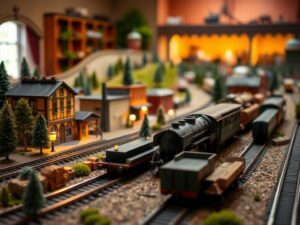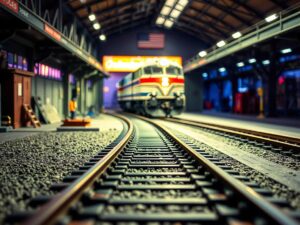How to Build Your First HO Scale Layout
How to Build Your First HO Scale Layout
How to Build Your First HO Scale Layout: From Dreaming to Delivering
Welcome aboard fellow rail enthusiasts! The world of model railroading is a fascinating blend of creativity, engineering, and history, where your imagination can run wild (much like a well-maintained train on an endless track!). And today, we’re going on a journey together to explore the exciting process of building your very first HO scale layout.
Before we dive into the details, let’s define our terms. HO scale is a popular standard in model railroading where everything is roughly one eighty-seventh (1:87) the size of its real-life counterpart. This scale allows for detailed modeling while maintaining a manageable size suitable for home layouts.
This guide will walk you through each step, from planning to construction, making sure that even the newest enthusiast feels empowered to build their dream layout. Let’s get started!
1. Conquering the Layout Canvas: Planning Your Paradise
Think of this as the blueprint stage – the foundation for your railroad masterpiece.
-
Defining your Scope:
First, answer some key questions. What kind of rail system do you envision? A sprawling network with complex switching and signal systems or a scenic loop showcasing mountainous terrains and charming towns? Consider what sparks joy â passenger lines with grand stations, industrial yards teeming with activity, or serene countryside views? Your passion will guide your vision.
-
Space Assessment:
Realistically evaluate the available space in your chosen location. Remember to factor in table height for comfortable viewing, walkways around the layout for accessibility, and potential for future expansion.
-
Track Planning – The Backbone of Your Rail Network:
HO scale track layouts are diverse, with options like continuous loops, oval circuits, point-to-point lines, or intricate combinations incorporating branches, spurs, and yard facilities.
-
Popular Resources: Online tools and books can provide pre-designed templates for inspiration or a starting point for your own customized layout. Consider resources like SCARM software, which allows you to visualize track plans in 3D.
-
The Importance of Prototyping: Before laying down any permanent track, build a temporary “mock-up” on plywood using straight sections and flexible track curves. This helps you fine-tune your track plan and ensures smooth train movements.
-
-
Elevations and Scenery – Adding Depth and Dimension:
Varying elevations add realism and visual interest. Experiment with foam board or cork roadbed to create hills, valleys, bridges, and tunnels. Think about how these features will affect your track plan and how you’ll incorporate them into your scenic design.2. Gathering Your Tools – A Well-Equipped Workshop:
To bring your HO scale layout to life, you’ll need a few essential tools:
- Track Laying Tools: Track gauge (measuring the width between rails), nippers for trimming wire and plastic parts, pliers for bending wire, soldering iron with solder for making secure track connections, rail joiner for joining track sections, cork cutter or hobby knife.
- Construction Tools: Measuring tape, pencil, level, square, ruler, hand saw or coping saw, utility knife, craft glue (like CA glue for rapid adhesion), wood carving tools for scenic features, clamps.
3. Building the Foundation – Roadbed and Supports:
- Roadbed Choice: The roadbed serves as the base for your track, supporting it while providing drainage for your scenic work. Common options include cork roadbed strips, foam board insulation (like pink or blue rigid foam), and wooden plank roadbeds.
- Secure Placement: Depending on the materials you choose, secure the roadbed to your base using wood glue, double-sided tape, staples, or nails. Level it thoroughly for a smooth foundation.
4. Laying Track – Bringing the Lines to Life:
This is where the magic begins! Following your carefully planned track diagram:
- Begin with Outer Loop: Constructing an outer loop provides a stable base upon which to build further expansions.
- Utilize Connectors: Connect individual track pieces with appropriate joiners, ensuring snug connections for smooth train operation.
5. Electrification and Wiring – Giving Trains the Spark of Life:
- Power Supply: An HO scale power pack provides electricity to your trains. Select a pack capable of delivering sufficient current based on the length of your layout and number of trains you’ll operate.
- Wiring Harness:
This intricate network connects power from the supply to each section of track. Utilize stranded copper wire, color-coding for easy identification, and proper electrical insulation (tape or sleeving) throughout.
6. Bringing Scenery to Life – Your Masterpiece Unveiled:
-
Ballast Material: Choose a ballast material (such as crushed rock or gravel) that complements your chosen setting. Sprinkle it over the track after you’ve secured all the wires.
- Painting Techniques: Employ dry brushing, washing, and layering techniques to add texture and realism to buildings and landscapes.
-
Water Effects – Reflections of Magic:
Using liquid resins or commercial water effects, you can create serene lakes, bubbling streams, and realistic puddles on your layout.
7. Final Touches and Operating Your Railroad:
- Signaling System – Guiding the Trains: (Optional but Adds Depth)
Implement a signaling system using miniature semaphore signals or LED indicators to control train movement along your lines, adding realism and challenge to your operation.
- Trains & Locomotives:
Choose locomotives and rolling stock that complement your chosen layout theme.
Insights for Newcomers Building their First HO Scale Layout:
-
Start Small, Dream Big: Don’t be overwhelmed by grandeur; a modest beginning allows you to learn the ropes and build gradually. Expand as your experience and confidence grow!
-
Embrace Community Support: The model railroading world is incredibly welcoming. Join clubs, attend train shows, or engage online forums for advice, inspiration, and friendships forged through shared passion.
-
Don’t Be Afraid to Experiment: Try new techniques, incorporate unusual features, and personalize your layout. There are no hard and fast rules â your imagination is the limit!
Most importantly, enjoy every step of this journey. Building an HO scale layout is a rewarding experience filled with creative expression and the joy of bringing miniature railways to life. Now, go out there and build your dream!




